The Movement Trigger Toolkit
Recently, I had an epiphany that has changed my entire outlook on exercise. I'm no longer fighting it; it's not this elusive thing anymore that I do for a few days and then stop for some reason, forgetting the last time I did it.
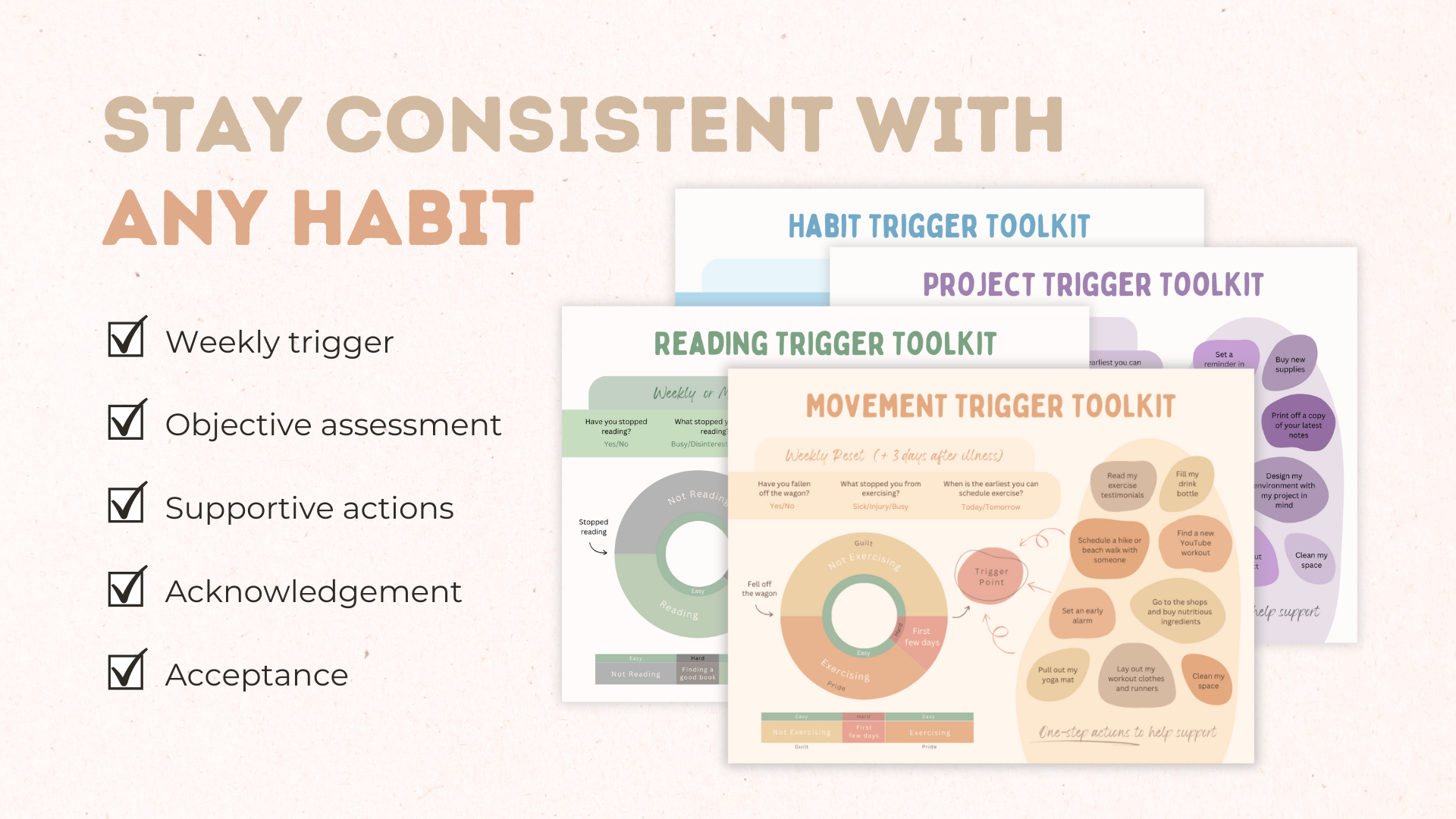
Exercise has been one of my New Year's resolutions ever since I can remember. I've exercised on and off but have never been able to stick to it consistently.
Recently, I had an epiphany that has changed my entire outlook on exercise. I'm no longer fighting it; it's not this elusive thing anymore that I do for a few days and then stop for some reason, forgetting the last time I did it. I used to try and force it, telling myself, "I have to exercise," "I should be exercising," and feeling bad if I wasn't exercising, thinking I'm lazy or unfit.
Firstly, berating yourself for anything will not make you consistent with that thing. It might motivate you in the short term, but name-calling and treating yourself poorly will only lead to feeling worse and eventually becoming demotivated. It's important to lead with self-compassion and avoid judging yourself.
The Movement Trigger Toolkit
My epiphany surrounding exercise led me to create the Movement Trigger Toolkit. The exciting thing about this toolkit is that it can be used for more than just exercise; it can be used for any habit that you do on and off. I'll start with exercise and explain how it can be adapted later on.
The first important thing to note is that I realised that exercise is easy for me while I'm doing it. The difficult part is those first few days after not exercising for a while. Not exercising is easy; it takes no effort. I might feel guilty while I'm not exercising, but it's easy not to.
Exercising is also easy once I'm in the routine of it, and instead of feeling guilty, I feel proud of myself while I'm exercising. But it's just those few days in between that are the hard part. It's difficult because once you haven't done something in a while, you have to stretch out your comfort zone again, and that can cause discomfort.
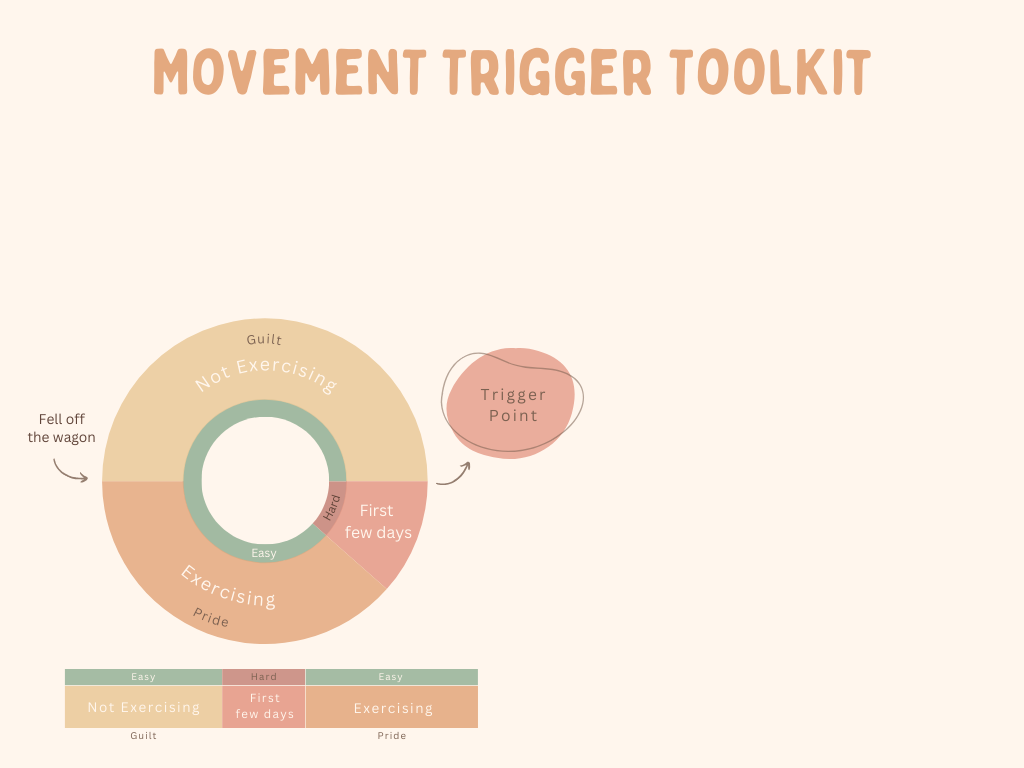
Why Do I Stop Exercising?
I reflected on why I stop exercising and realized that there are only three reasons: when I'm sick, when I'm injured, and when I get busy. These are the reasons I stop exercising, and I haven't really come across another reason. Sometimes it might feel like there are many reasons, and busy does encompass a lot of things, but the majority of the time, it's when I get sick or injured, and I stop exercising purposefully but then fall off the bandwagon and forget to get back on again.
The good thing about being busy is that once you acknowledge that it shouldn't stop you from exercising, it kind of doesn't stop you anymore. You can consciously decide, "Okay, I know that I'm busy, but I'm going to make sure that exercising is a priority." The other two reasons—sickness and injury—are trickier because it's important to rest when you're sick or injured. However, once I fall off the wagon, that hiatus can go on indefinitely because there's nothing to trigger me to start exercising again. Usually, it would require me to feel bad enough about myself to start exercising again, and that is not a healthy cycle to be in.
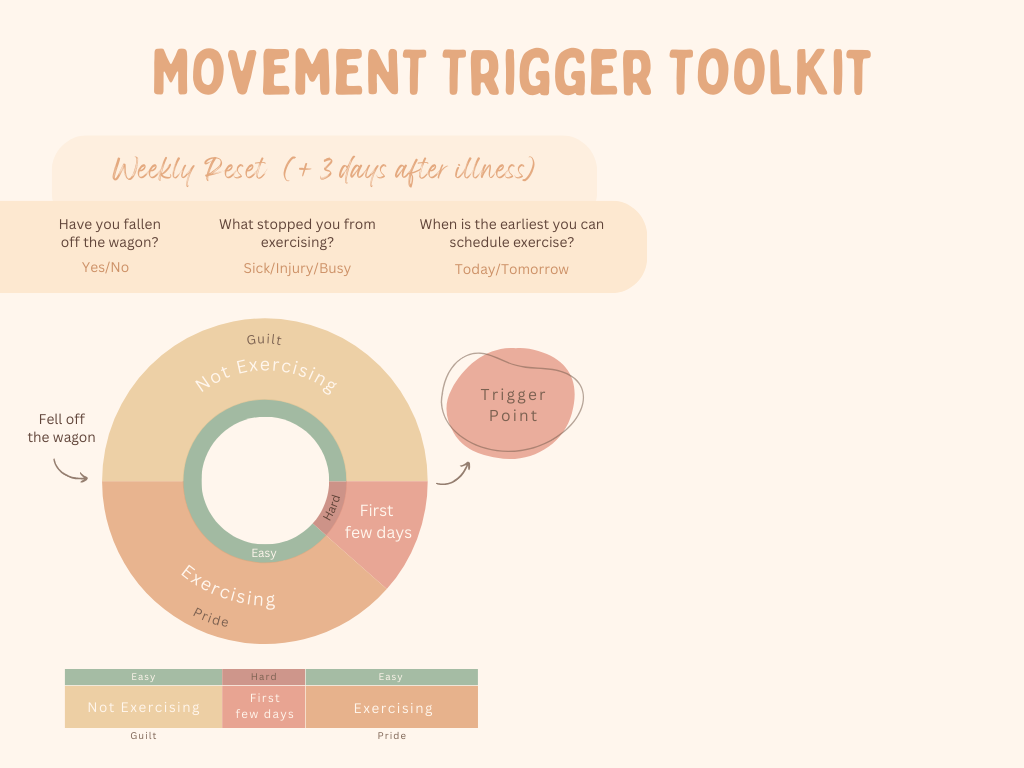
How to Trigger Yourself to Exercise?
That's where the Movement Trigger Toolkit comes in. I needed something positive to trigger that cycle again. Instead of waiting for something to eventually trigger me, I would artificially create a trigger for myself. This toolkit is now part of my weekly reset. Each week, I ask myself three questions and answer these questions objectively with no judgment: Have I fallen off the wagon with exercise? If the answer is yes, what was the reason for me falling off—was I sick, injured, or busy, or was it something else? This helps me reflect on what causes me to stop exercising the most. The last question is, When can I schedule exercise, either today or tomorrow? If I'm really unwell at the time of doing my reset, I'll usually put a reminder in my calendar to check in a few days later.
Now that I've created this trigger for myself every week, I've gotten in the habit of thinking about exercise more, and I'm finding that I answer no to falling off the wagon far more often. As an added bonus, because I'm so aware of the three reasons that cause me to stop exercising, they don't stop me as often anymore. When I'm injured, I find alternative exercises I can do to allow that part to heal. When I'm busy, I don't let that be an excuse for not getting in some form of exercise, even if it's just a seven-minute HIIT workout or a quick walk outside.
I'm no longer having to rely on willpower to exercise. I know that I can rely on my weekly reset instead. I do have a video on my full weekly reset, which I'll leave linked in the description below.
Supportive Actions to Help You Exercise
In addition to acknowledging the cycle and the three questions, I also added a list of one-off support actions I can take to help those first few days be less difficult. What would happen previously is I would realize that I wasn't exercising and then put exercise on my to-do list, but there is so much resistance towards that word, especially when it's outside your comfort zone after not having exercised for a while. Instead, I found small things that I can do that support my exercise habit, such as filling up my water bottle, laying out my workout clothes, and picking out new YouTube workouts. These are all things that will help me exercise but aren't just exercise itself. I don't have any resistance towards laying out some clothes or filling up a drink bottle, so these are all the things that make up my Movement Trigger Toolkit.
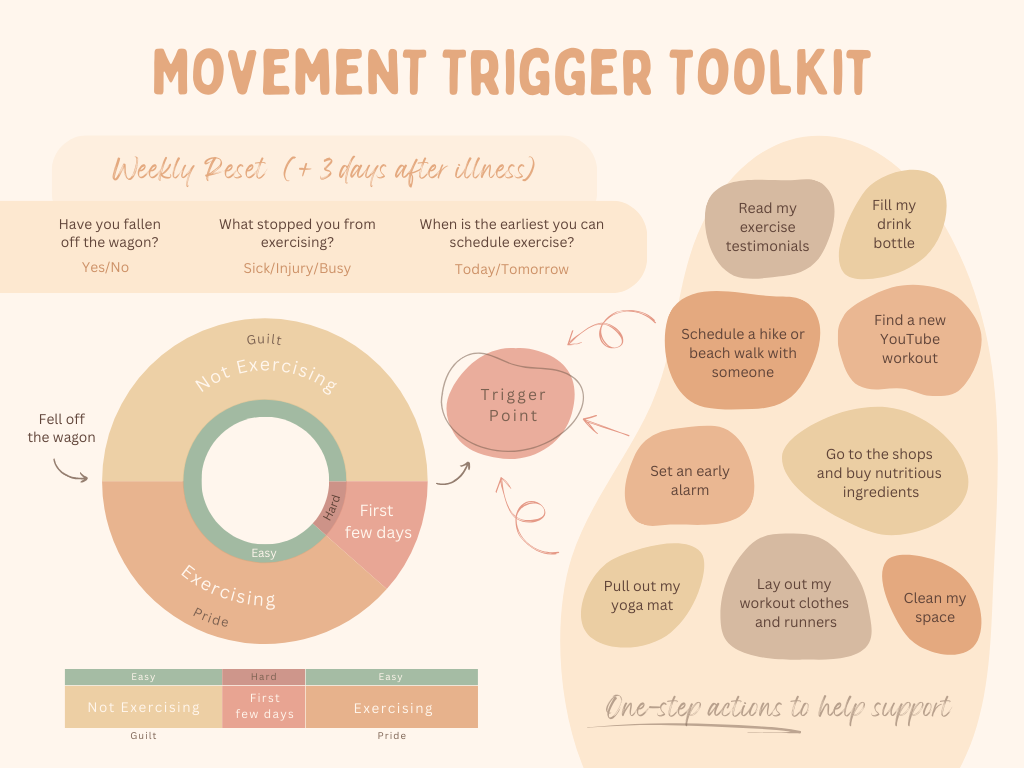
How to Stay Consistent with Any Habit?
I mentioned at the start of this video that this toolkit can be adapted to any habit that you do on and off. I'll explain how. I was thinking about this toolkit and realized the same principles could be applied to reading. Then I realized, hang on, it could be applied to anything where you go for periods of time without doing it and then are triggered to do it again, like meditating, creative projects, or side hustles. There are so many applications for this toolkit.
Let's use the example of reading. Many people want to read more, but reading slumps are definitely a thing. So if I were creating this toolkit for myself, this is how I would make it: Have I stopped reading, yes or no? What made me stop—either I got busy, wasn't liking the book I was reading, or don't have a book that excites me? When can I get back into this habit—either today with a book that I have or after buying a new book? Supportive actions I can take include putting a book on my bedside table, making a new bookmark, reading spoiler-free reviews of books I want to read, or setting an alarm to go to bed 30 minutes earlier. You can see how this trigger model fits perfectly with a reading habit too.
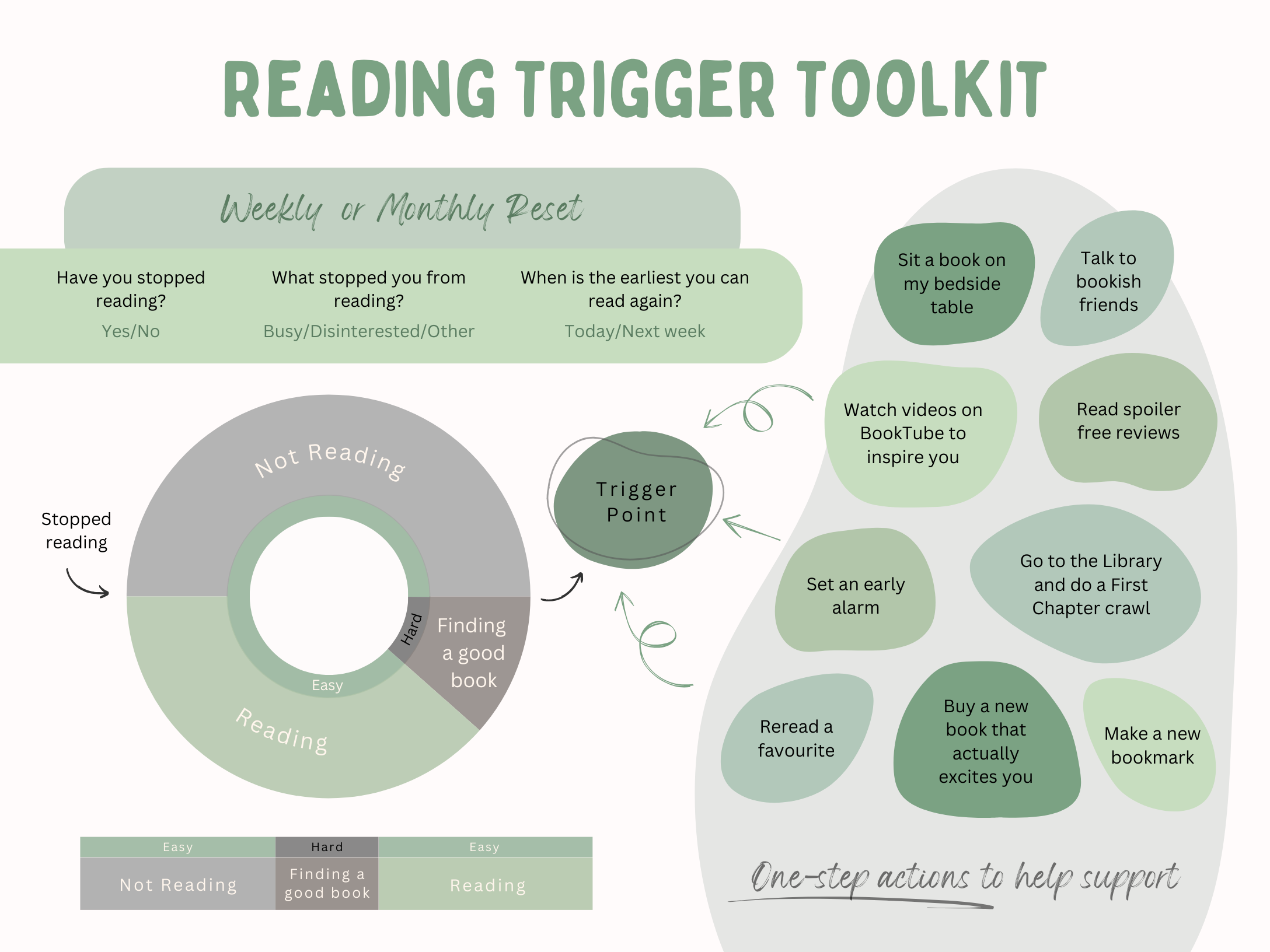
If there are habits that you sometimes do consistently and then sometimes fall off the wagon, I highly recommend sitting down and thinking about the relationship you have with the habit. Ask yourself what is stopping you from doing this habit, how you feel when you're doing this habit versus when you're not, what triggers you to start again, and if there are any supportive actions you can take to start the cycle back up again.
You can download this Trigger Toolkit and edit it to suit you! This may be what you need to stay consistent with your habits, in a way that feels good! It helps you reflect on your relationship with your habits and determine what is stopping you and creating a positive trigger for the things you're wanting in your life!

